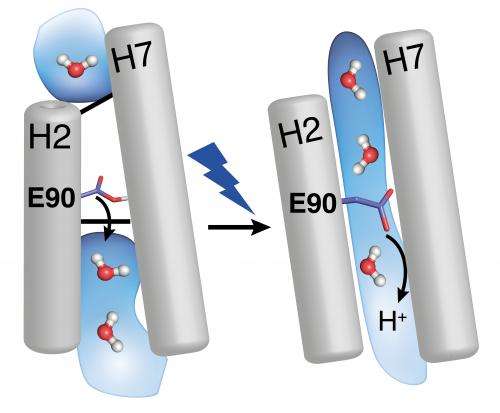Protein channelrhodopsin-2 findings facilitate manufacture of bespoke optogenetic tools

Researchers have shed light upon the mode of action of the light-controlled channelrhodopsin-2 with high spatiotemporal resolution. This biomolecule is used in optogenetic applications, which is deployed to control the activity of living cells with light. "The model we developed makes it possible to create customised optogenetic tools for individual applications," says Prof Dr Klaus Gerwert from the Department of Biophysics at the Ruhr-Universität Bochum. Together with colleagues at the Humboldt Universität zu Berlin from the team headed by Prof Dr Peter Hegemann, the Bochum researchers report about their finding in the magazine Angewandte Chemie.
Channelrhodopsin-2 has revolutionised optogenetics
Discovered by Peter Hegemann in green algae, channelrhodopsin-2 is the central light-activated channel protein in optogenetics. If this ion channel is applied to nerve cells, the channels can be opened by light, thus activating the cell. "The application of channelrhodopsin-2 in optogenetics has revolutionised neurobiology in the recent years," says Klaus Gerwert. The magazine "Nature Methods" awarded this process as "Method of the Year" in 2010. "However, scientists had not been aware of what is actually happening inside a protein and thus ultimately triggers its activation," continues the Bochum researcher. But it is the understanding of processes on the atomic level that is essential for optimising the protein specifically for its applications.
"EHT" model describes the mode of action of channelrhodopsin-2
With time-resolved vibrational spectroscopy and bio-molecular simulations, the Bochum-Berlin team has now closed that gap. The EHT (E90-Helix2-tilt) model describes the mode of action of channelrhodopsin-2 as follows: the light-sensitive group of the protein, i.e. the retinal, is twistedunder incidence of light. This twist then continues in the protein and opens a pore ultra fast, which is closed by amino acid E90 in the dark. E90 marks the narrowest place in the pore and opens it through a downward move , similar to the motion of a swing door, so that water can enter an empty vestibule above the narrowest place in the pore. The entering water then tilts the protein helix H2, which eventually triggers a protein-traversing open ion channel. When forming this model, the Bochum researchers benefitted from their comprehensive experience that they had gained resolving the mechanism of light-driven proton pump bacteriorhodopsin in detail.
"Protein engineering": pioneering novel optogenetic tools
"With this structural model, the next step, i.e. protein engineering, will become possible," explains Klaus Gerwert. Through mutation of the amino acid E90, the protein's properties can be controlled in a targeted manner. The conductivity or the selectivity for certain ions could be customised for specific applications, and the protein could be specifically activated with different wavelengths.
More information: J. Kuhne, K. Eisenhauer, E. Ritter, P. Hegemann, K. Gerwert, F. Bartl (2014): "Early Formation of the Ion-Conducting Pore in Channelrhodopsin-2," Angewandte Chemie International Edition, DOI: 10.1002/anie.201410180
Journal information: Angewandte Chemie , Angewandte Chemie International Edition
Provided by Ruhr-Universitaet-Bochum


















